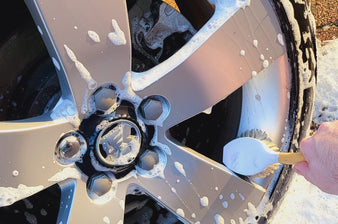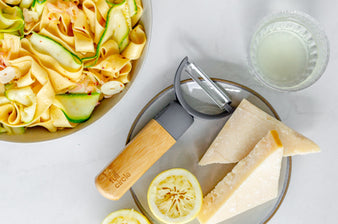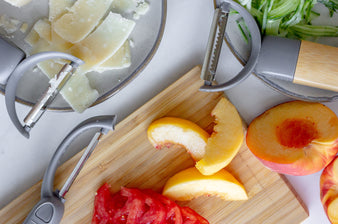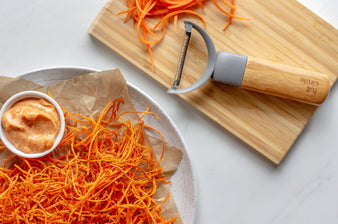Materials, For Good.
When we set out to create a new range of do-good products, choosing appropriate materials was a top priority. Not only do these materials come from cleaner sources, but they also have a better end-of-life fate. On top of all of this, our For Good products don’t compromise on quality or functionality.
Let’s dive a little deeper into how we selected these materials, for good.
Appropriate Materials
Plastic is an undoubtedly good material—until it isn’t. It makes cleaning, cooking, and storing much easier. It’s a perfect material to keep apple slices fresh for an afternoon snack or dough snugly covered as it rises. However, what happens after the plastic’s been used presents some problems.
Most of the plastic we use in the kitchen is of the disposable variety, meaning that it ends up in the trash can (requiring yet anotherplastic product!). The most common type of plastic, polyethylene, takes hundreds of years to break down. As it does, it releases dangerous microplastics into the environment.
Because we know how useful things like zipper bags, trash bags, and food wrap are, we wanted to make something just as efficient—but kinder on our planet after it’s been used.
So, we put a sustainable spin on this commonly used material by instead turning to PLA and PBAT. Used in trash bags, zipper bags, and food wrap, they’re just as strong and useful as conventional plastic, but their compostability makes them better for our planet.
- Polylactic acid, or PLA, is a type of polyester that’s produced using fermentation to transform a carbohydrate source like sugarcane or corn starch into a fully bio-based and biodegradable plastic.
- Similarly, PBAT, or polybutylene adipate terephthalate, is a biodegradable polymer also made from plants. While it does contain some petrochemicals (oil), it can safely and quickly biodegrade without leaving any harmful toxins behind.
Once exposed to the temperatures, microorganisms and humidity of an industrial composting facility, both PLA and PBAT will break down into water, carbon dioxide, and earth—not microplastics.
What about the parchment paper rolls and sheets? Surely these don’t need a big change since paper is safe and sustainable, right? Well, unfortunately most parchment paper is chlorine bleached, meaning that it has the potential to release toxic dioxin when heated. And isn’t the main purpose of parchment paper to be heated?! So we explored some better options here, too.
For Good Alternatives to the Standard
Until we figure out a way to easily take out the trash without a bag, or something to store carrots or crayons, there’s a need for products like these. Plastic made with plants doesn’t break down into tiny microplastics that have a macro negative impact on ecosystems and wildlife. Instead, it becomes earth!
It’s clear that our For Good line of products is safer for our planet, and because we avoid dioxin-producing chlorine bleach, it’s safer for you, too. When you're making chocolate chip cookies, the last thing you want to think about is the potential for dangerous chemicals, right? That’s why our For Good range has been designed for you.
Baking, Storing and Cleaning, For Good
Sustainable? Check. Safe? Check. Functional? Check.
Like everything else from Full Circle, For Good takes the essentials you know and love, and just makes them in a better way. We scoured the globe for the best materials, studied what happened to them post-use, and ensured that they safely work in the way they’re supposed to. Now it’s up to you to use them in your home, for good.




